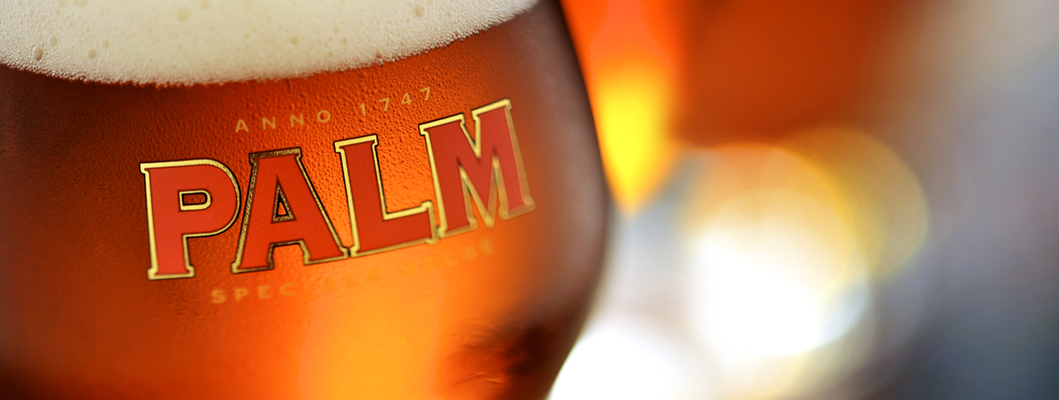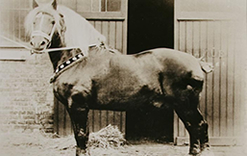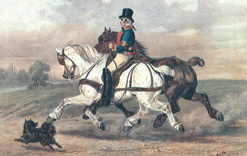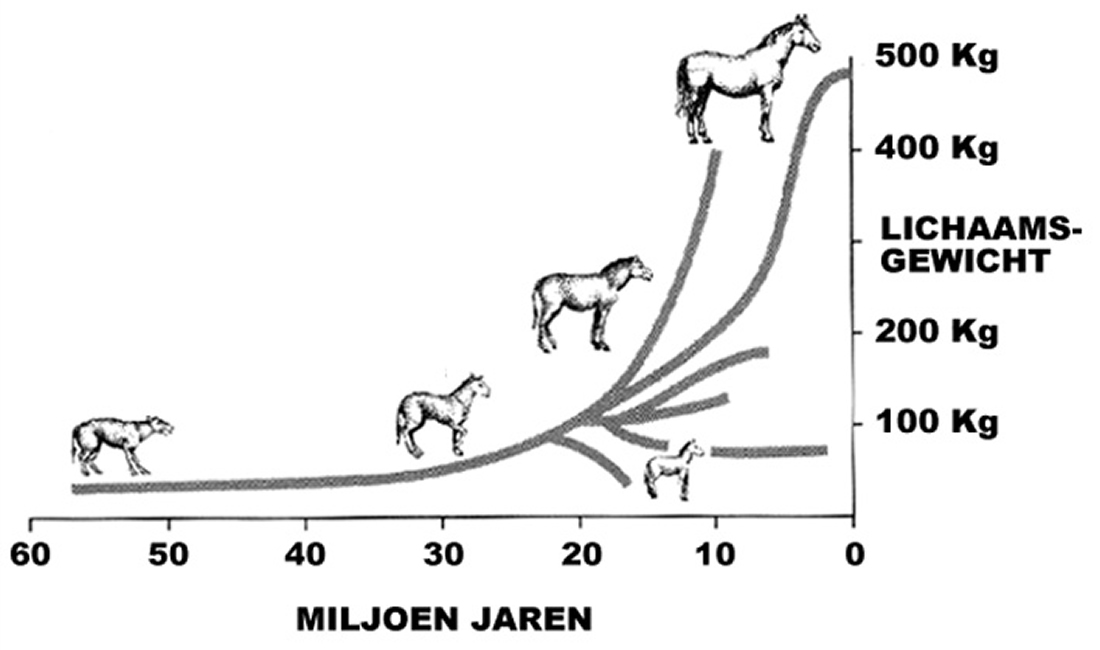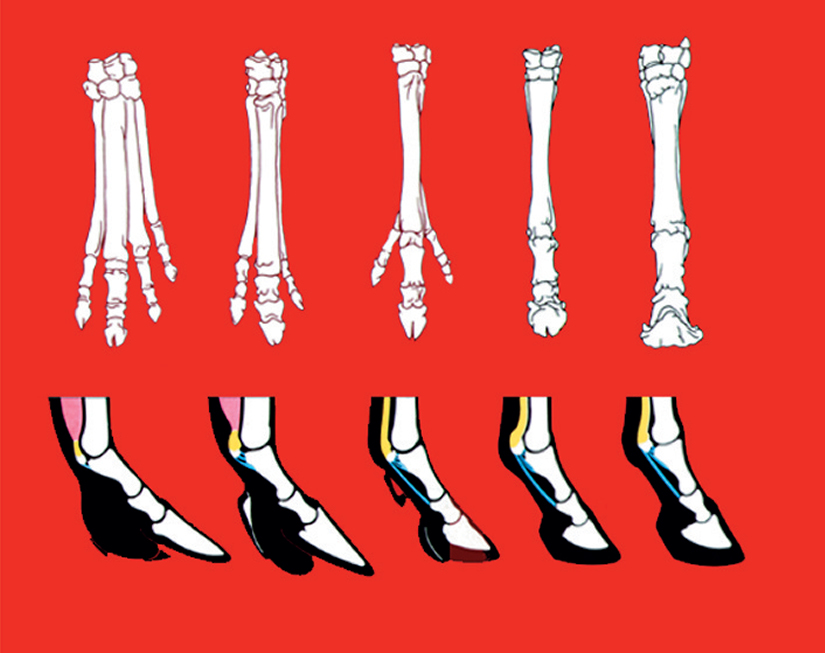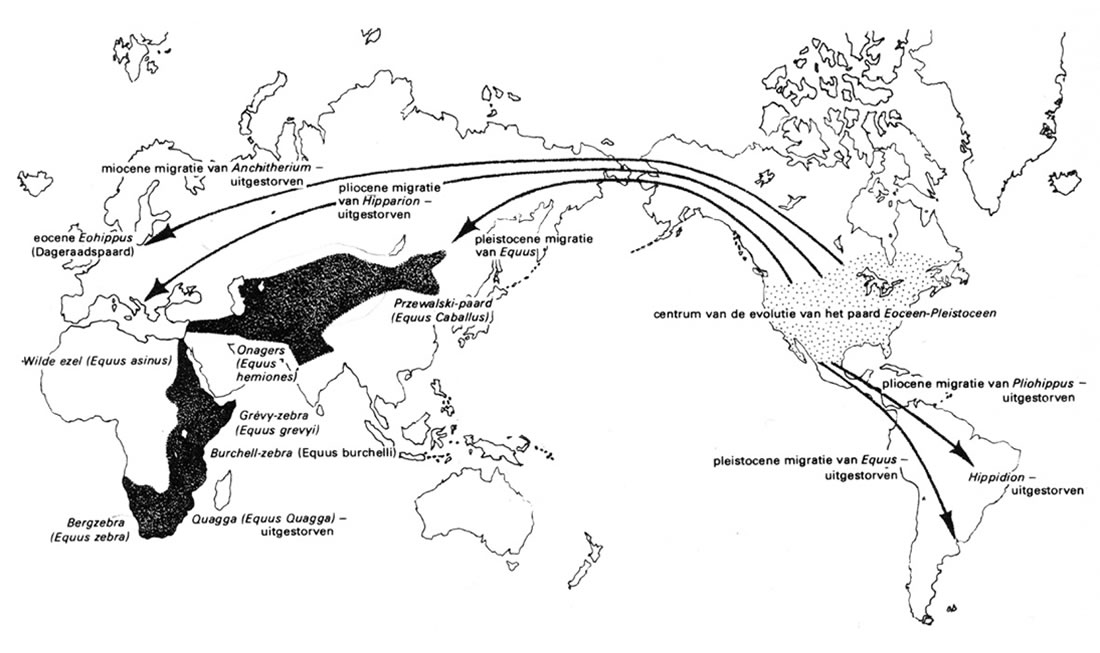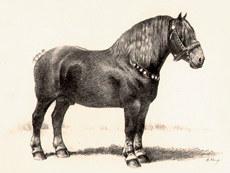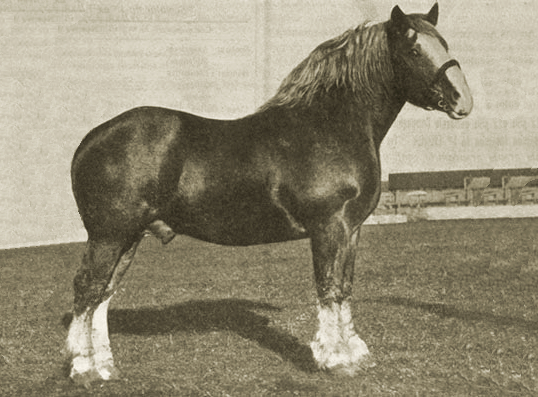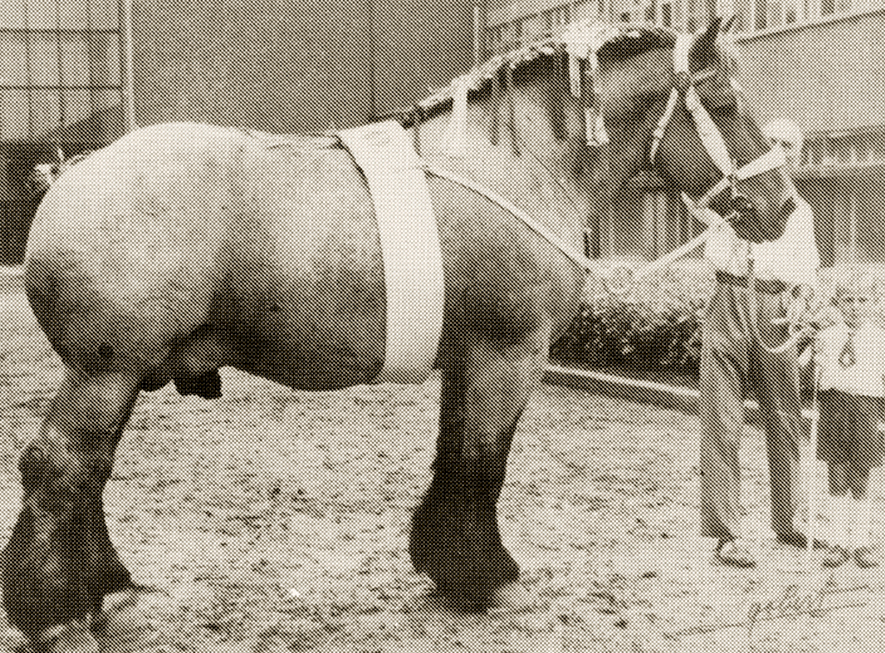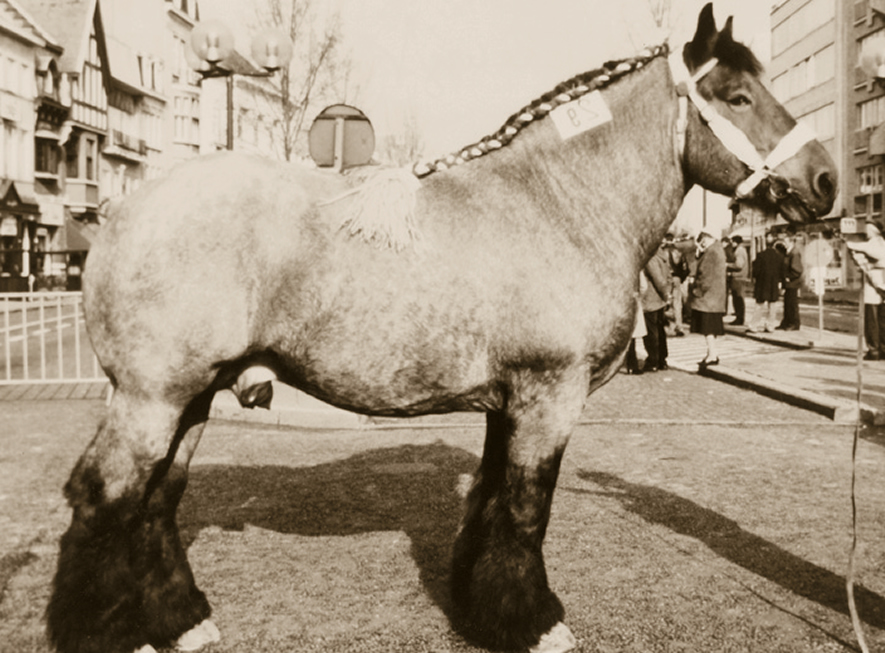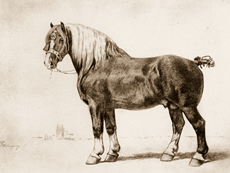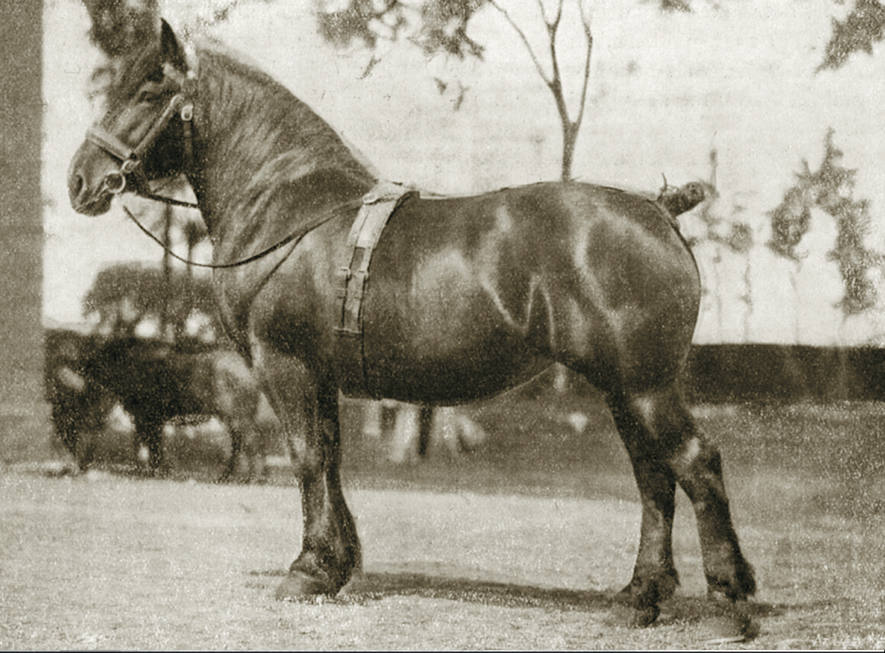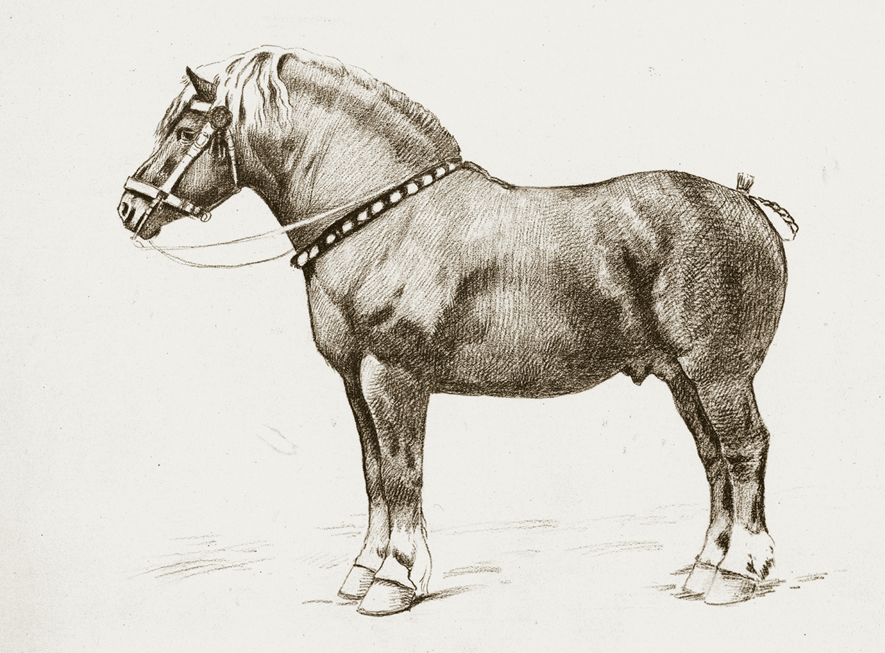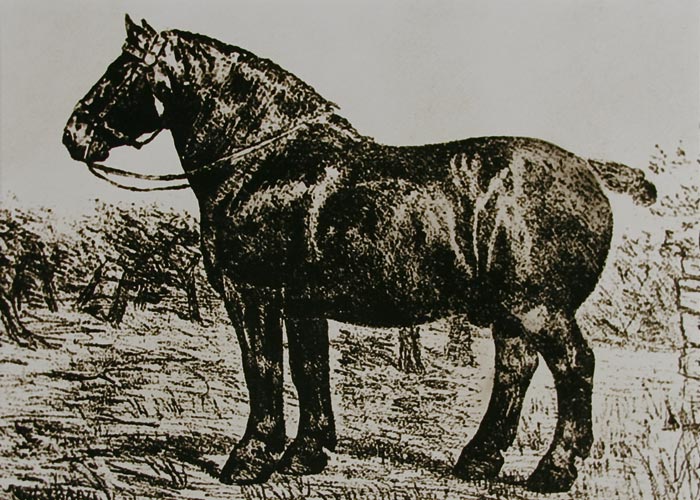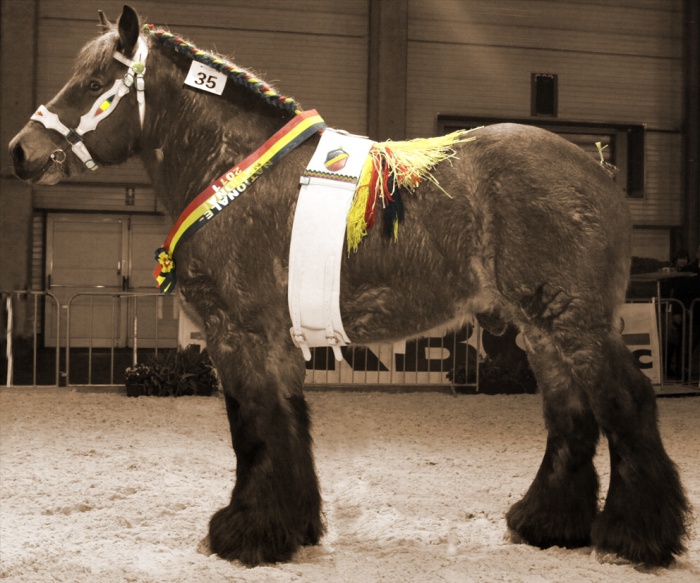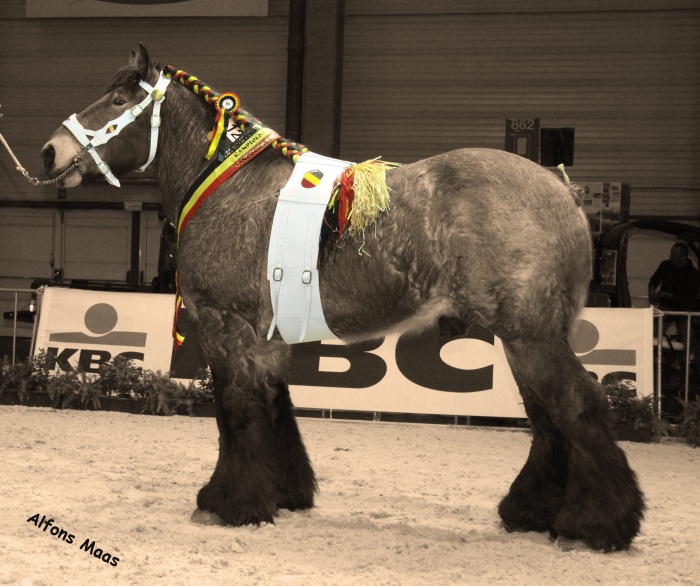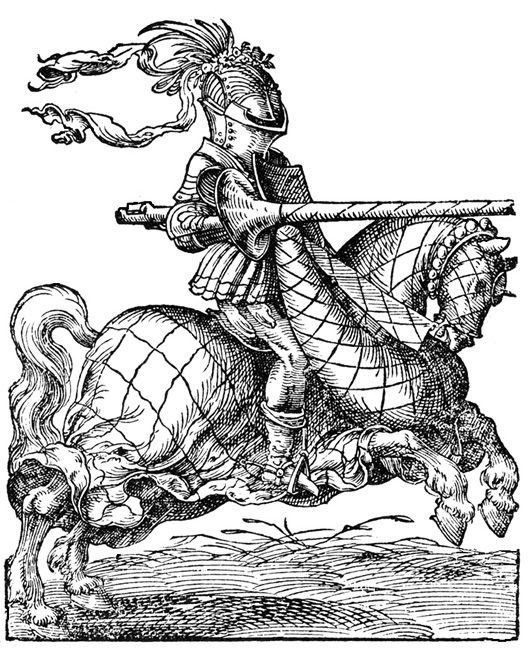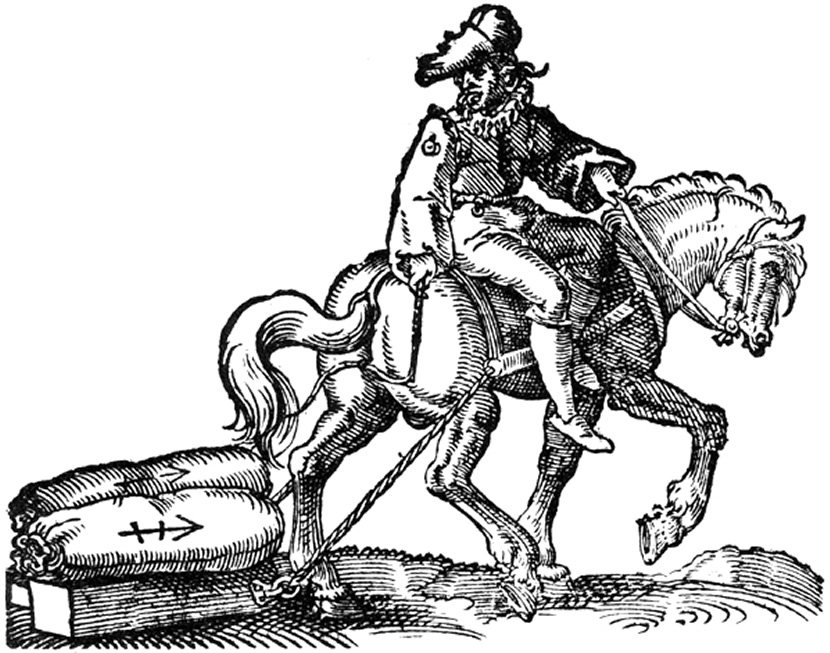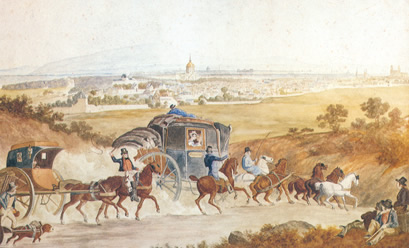History of the Belgian draught horse
Origin of the draught horse
The horse, later followed by the donkey and the zebra, developed from a common ancestor (the Eohippus) about four million years ago.
The horse (Equus caballus) further developed into four types. These "prototypes" were the forefathers of our present-day horses. Depending on the environment in which they ended up, they evolved into the primitive pony, the steppe horse, the Arabian horse or the Tundra horse. The draught horse developed from the Tundra horse.
Origin of the Belgian draught horse
The Belgian draught horse originated from four local types:
the Flemish horse, the "Big Horse of the Dender", the "Grey of Hainaut" and the "Colossal Horse of Méhaigne".
The ROYAL SOCIETY OF THE BELGIAN DRAUGHT HORSE (KMBT) studbook turned one breed into Belgium's leading export.
Gallery of champion stallions
The studbook for the Belgian draught horse is organised by the Koninklijke Maatschappij het Belgisch trekpaard (KMBT - Royal Society of the Belgian Draught Horse).
Since 1886 the studbook has organised the annual championship inspection for draught stallions and mares. All the champion stallions and mares can be admired at Diepensteyn Castle. It is very easy to track the evolution from workhorse to show horse and for meat.
Here you will find a taster of the gallery of champion draught stallions.
Use of draught horses in the past & today
The draught horse was never a product of nature, but rather of man. The practical value of draught horses for the economy disappeared with the arrival of the internal-combustion engine. A new direction is undoubtedly recreational and competitive use.
The horse, later followed by the donkey and the zebra, developed from a common ancestor (the Eohippus) about four million years ago.
The horse (Equus caballus) further developed into four types. These "prototypes" were the forefathers of our present-day horses. Depending on the environment in which they ended up, they evolved into the primitive pony, the steppe horse, the Arabian horse or the Tundra horse. The draught horse developed from the Tundra horse.
The draught horse developed from the Tundra horse. At that time stallions and mares lived close to each other in large herds. Their mutual tolerance is great, their build strong and heavy. We can trace various characteristics displayed by our present-day draught horse back to this primitive ancestor: a round rib cage and a large stomach and intestinal volume (necessary in order to obtain sufficient energy from an overly poor diet), their gigantism, their muzzle with small, high-positioned nostrils, heavy weight on the legs and so on. The present-day draught horse is not however a primitive pony but rather the result of breeding by man.
The Belgian draught horse originated from four local types: the Flemish horse (1), the "Big Horse of the Dendre" (2), the "Grey of Hainaut" (3) and the "Colossal Horse of Méhaigne" (4).
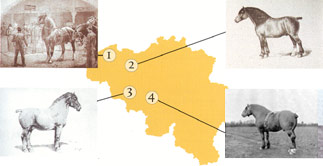
Belgium was once in a very strong economic position in Europe, the leading export item being horses, primarily to Germany and Russia. In those days many countries used Belgian stallions to cross with the local stock. The Belgian draught horse was thus one of the country's main exports.
The horse had to meet industrial requirements. In 1886 the "LE CHEVAL DE TRAIT BELGE" studbook was set up, with the aim of breeding strong, uniform stock. Indeed, Belgian draught horses won prizes at shows and exhibitions all over the world.
1863
Gugusse-Orange I
All current studbook horses in Begium are descended from this remarkable stallion.
Brin d'Or (brown), son of Jupiter and national champion 1900.
Jupiter (chestnut) national champion (1889), father of the famous sons from the Jules Hazard stable.
Following the invention of the internal-combustion engine, transport was mechanised while a few years later the army chose tanks over horses. A whole generation of young farmers had lost their lives by the end of World War I. The draught horse market changed as a result, becoming very small. The only market for the horses was transport over short distances and agriculture. The heavy loads that had to be drawn called for a heavier type of horse: "kilos to move kilos". Speed was less important as the travelling distance was shorter. This dramatically altered the breed.
1914
Indigène de Wisbecq
Sold to the Netherlands for fear it would be claimed by the German occupiers.
Formed the basis of the Dutch Draught Horse Stud Farm.
Albion d'Or
(champion 1923), grandson of Indigène du Fosteau. Forefather of the present-day "black type".
Espoir de Quaregnon
(champion 1929). Son of Avenir d'Herse, sold for a record BFr 1,000,000.
Matador de Buvrinnes
(champion 1954) Bred massive and very agile foals. Sold to Germany too early.
Ensor d'Elewijt
(champion 1991)
Is the prominent stud for current breeding.
Brillant won first prize at the Paris International Horse Show in 1878.
International Belgian draught horse triumphs in the 19th century.
Brillant international champion in Paris in 1878.
Father: Gugusse-Orange I.
Mother: Blonde
Bella de Plançenoit
(champion 1909-1910-1911) (brown) top mare, mixed the blood of Flemish and Hainaut horses.
Rêve d'Or (chestnut), son of Jupiter and champion of all draught horse stock, at the Paris International Show in 1900.
Indigène du Fosteau
(champion 1906-1907-1908-1909), outcome of an intensive inbreeding policy adopted by Jules Hazard. Forefather of all present-day stud horses.
Within a few years we can see how the champion stallions became heavier and the dominance of the Albion d'Hor line got under way. This stallion dominates the breed to this day through his son Avenir de Herse and mainly through his grandson Espoir de Quaregnon!
Avenir d'Herse
(kampioen 1925) Zoon van Albion d'Or.
Between 1918 and 1930, not only the colour but also the type of horse changed. The work athlete of World War I, which had a broad colour variation, dry legs and could walk and trot all day long, changed into the strong draught horse of the 1920s and 1930s. When hydraulics and tractors emerged in the 1920s, the horse's role in agriculture was as good as finished.
Between 1920 and 1950 we see the breed getting heavier and heavier. The only selection takes place in the "showring".
When studying the types of mare and stallion, we see a clear difference in development between 1918 and 1950-55. The mare continues to look like the original Belgian type for much longer. In the meantime the stallions are becoming much heavier.
When eventually the small farmer bought a tractor in the 1950s, the type of mare changed from the "working" to the "show" type (i.e. heavy type) over the course of 10 years. The only remaining selection was in the "showring".
1886
Name:
Sultan
Breeder:
Boden L.
Owner:
Boden L.
1887
Name:
Mercure
Breeder:
Chevalier L.
Owner:
Dumont de Chassart E.
1888
Name:
Mouton
Breeder:
Corbusier N.
Owner:
Orban G.
1889
Name:
Jupiter
Breeder:
Staquet M.
Owner:
Boucqueau L.
1890
Name:
Brillant
Breeder:
Depercenère L.
Owner:
MM. Reginster Frères
1891
Name:
Gerfaut II
Breeder:
Vanderschueren C.
Owner:
Vanderschueren C.
1892
Name:
Pierrot
Breeder:
Neunez A.
Owner:
Neunez A.
1893
Name:
Blanqui
Breeder:
Peten C.
Owner:
Peten C.
1894
Name:
Mont d'or
Breeder:
Jourez L.
Owner:
Jourez L.
1895
Name:
Mont d'or
Breeder:
Jourez L.
Owner:
Jourez L.
1896
Name:
Olympien
Breeder:
Hautier J.
Owner:
Hautier J.
1897
Name:
Favori
Breeder:
Vve Mathieu
Owner:
Mathieu Frères et Soeurs
1898
Name:
Rêve d'or
Breeder:
Nerinckx-Cloquet E.
Owner:
Guyaux S.
1899
Name:
Pirate
Breeder:
Duvieusart A.
Owner:
Meeus H.
1900
Name:
Brin d'Or
Breeder:
Mme Vve Francotte, Pont à Celles
Owner:
Hazard J. - Leers et Fosteau
1901
Name:
Bienvenu
Breeder:
D'Hauwer T.
Owner:
D'Hauwer T.
1902
Name:
Bourgogne
Breeder:
Depauw Frères et Soeurs
Owner:
Tirtiaux F.
1903
Name:
Marquis de Rosseignies
Breeder:
Vve Baude J.B.
Owner:
Vve Baude J.B.
1904
Name:
Marquis de Ruyen
Breeder:
Vve Van Enis
Owner:
Vandenhende M.
1905
Name:
Gambrinus du Fosteau
Breeder:
Hazard J.
Owner:
Cobbaut C.
1906
Name:
Indigène du Fosteau
Breeder:
Hazard J.
Owner:
Van Landuyt J.
1907
Name:
Indigène du Fosteau
Breeder:
Hazard J.
Owner:
D'Hauwer T.
1908
Name:
indigène du Fosteau
Breeder:
Hazard J.
Owner:
D'Hauwer T.
1909
Name:
Indigène du Fosteau
Breeder:
Hazard J.
Owner:
D'Hauwer T.
1910
Name:
Bienfait de Masnuy
Breeder:
Poulet L.
Owner:
Dumont de Chassart G.
1911
Name:
Paul
Breeder:
Plovier G.
Owner:
Vandenhende H.
1912
Name:
Moustique de Grandglise
Breeder:
Duchateau G.
Owner:
Semal G.
1913
Name:
Infernal du Bois
Breeder:
Bury D.
Owner:
Bouvier P.
1914
Name:
Indigène de Wisbecq
Breeder:
Temmerman C.
Owner:
Temmerman C.
1919
Name:
Drinker D'Hondzocht
Breeder:
Deleener A.
Owner:
Deleener A.
1920
Name:
Prince Léopold
Breeder:
Verderschueren A.
Owner:
Verderschueren A.
1921
Name:
Piot de Corroy
Breeder:
Vandenhende H.
Owner:
Vive Saint-Bavon
1922
Name:
Bourgogne de Saint-Martin
Breeder:
Carlier J.
Owner:
Maricq F.
1923
Name:
Albion d'Hor
Breeder:
Demarbaix Frères
Owner:
Delepine A.
1924
Name:
Idéal de Boneffe
Breeder:
Beguin J.
Owner:
Beguin J.
1925
Name:
Avenir d'Herse
Breeder:
Bourdiau Frères et Soeurs
Owner:
Bourdiau Frères et Soeurs
1926
Name:
Gaulois du Monceau
Breeder:
Bourdiau Frères et Soeurs
Owner:
Bourdiau Frères et Soeurs
1927
Name:
Successeur d'Herse
Breeder:
Bourdiau V.
Owner:
Delepine A.
1928
Name:
Carlo de la Maladrée
Breeder:
Fournier V.
Owner:
Fournier V.
1929
Name:
Espoir de Quaregnon
Breeder:
Vve Descamps A.
Owner:
Hazard Mme
1930
Name:
Favori de Neusart
Breeder:
Blondeau G.
Owner:
De Donder Frères
1931
Name:
Avenir de Solmonsart
Breeder:
Demeuldre V.
Owner:
Deleener
1932
Name:
Cocktail de Velm
Breeder:
Peten Cl.
Owner:
Peten Cl.
1933
Name:
Avare d'Emptinne
Breeder:
Baron Janssen L.
Owner:
Baron Janssen L.
1934
Name:
Idéal de l'Hove
Breeder:
Sacré Ed.
Owner:
Desenepart O.
1935
Name:
Royal de Salmonsart
Breeder:
Demeuldre V.
Owner:
Wilmots Frères
1936
Name:
Horizon de Bogaerden
Breeder:
Galmart A.
Owner:
Blampain E.
1937
Name:
Indigoli Delmotte
Breeder:
Vandercappellen M.
Owner:
Deleener G.
1938
Name:
Avenir de Promelles
Breeder:
Ponsar J.
Owner:
Paquet J.
1939
Name:
Vengeur de Vraimont
Breeder:
Van Cutsem V.
Owner:
Snyers C.
1946
Name:
Julien de Longpont
Breeder:
Vanderplasken E.
Owner:
Ancion A.
1947
Name:
Fiat de Montifaut
Breeder:
Buys P.
Owner:
Philips
1948
Name:
Costaud de Marche
Breeder:
Petit G.
Owner:
Fosseur A.
1949
Name:
Quo-Vadis de Houtaing
Breeder:
Deroissart E. Vve.
Owner:
Hautier M.
1950
Name:
Vadrouille d'Enée
Breeder:
Dubois J. en Malbecq E.
Owner:
Dubois J.
1951
Name:
Wallon de Libenne
Breeder:
Fosseur A.
Owner:
Descamp P., Desmet V., Boutiau M.
1952
Name:
Mastoc du Bois Maillet
Breeder:
Lecomte M.
Owner:
Rigo F.
1953
Name:
Monty des Bruyères
Breeder:
Maton A.
Owner:
Reintjes A. et Fils, Desmet V.
1954
Name:
Matador de Buvrinnes
Breeder:
François N.
Owner:
Pier X., Bayot A. Reintjens A. et Fils
1955
Name:
Fifils du Château
Breeder:
Langhendries L.
Owner:
Brasseur Ch., Firme d'Haens, Malbecq E.
1956
Name:
Gamin de l'Eaugrenée
Breeder:
Clerbois Frères
Owner:
Simoens Frères
1957
Name:
Super de Pierreux
Breeder:
Pauwels G.
Owner:
Derue R.
1958
Name:
Toto de Teignies
Breeder:
Bayot Ch.
Owner:
De Baene Al, Beguin V.
1959
Name:
Lucifer de Beauvoir
Breeder:
Brasseur Ch.
Owner:
Brasseur Ch.
1960
Name:
Diogène de Denville
Breeder:
Beauvois L.
Owner:
Louis P.
1961
Name:
Bijou de Bois
Breeder:
Vanneste G.
Owner:
Van Hollebeke M., Vandemeulebroeke U.
1962
Name:
Expo de la Sille
Breeder:
Beguin V., Ramskapelle
Owner:
De Baene A., St. Pieters-Brugge
1963
Name:
Emir de Salmonsart
Breeder:
Demeulder F.
Owner:
Demeulder F.
1964
Name:
Wisky de Bertinchamps
Breeder:
Paquet J.
Owner:
Paquet J.
1965
Name:
Costaud d'Impde
Breeder:
Van Doorslaer Fr. en Zoon
Owner:
Van Doorslaer Fr. en Zoon
1966
Name:
Buffalo de Romiée
Breeder:
Pesleux A.
Owner:
Simoens A.
1967
Name:
Marquis du Coq
Breeder:
De Saint Martin A.
Owner:
Simoens A.
1968
Name:
Barnum van 't Geushof
Breeder:
Debandt M.
Owner:
Simoens A.
1969
Name:
Tom van Sint-Kruis
Breeder:
Roels G.
Owner:
Leenaerts L., Debaene A.
1970
Name:
Hardi van 't Ooievaarnest
Breeder:
Simoens A.
Owner:
Simoens A., Carron E.
1971
Name:
Barnum II van't Geushof
Breeder:
Debandt M.
Owner:
Simoens A., Voet M., Verkest Ch.
1972
Name:
Barnum van 't Ooievaarnest
Breeder:
Simoens A.
Owner:
Simoens A., M. et Mme Raemdonck
1973
Name:
Matador de Salmonsart
Breeder:
Demeuldre F.
Owner:
De Baecker Gebr.
1974
Name:
Matador van't Hof van Nieuwe
Breeder:
Devos M.
Owner:
De Baene A.
1975
Name:
Yser de Behoute
Breeder:
Hanoulle A., Paquet R.
Owner:
Hanoulle A., Paquet R.
1976
Name:
Lutteur van't Ooievaarnest
Breeder:
Simoens A.
Owner:
Carron E.
1977
Name:
Hardi van't Geushof
Breeder:
Debandt M.
Owner:
Decroly C. en A.
1978
Name:
Baron van't Brouwerijhof
Breeder:
Van Overschelde O.
Owner:
De Backer Gebr.
1979
Name:
Marco Van Wilde
Breeder:
Muys F.
Owner:
Verkest Ch.
1980
Name:
Codex de Wolvertem
Breeder:
Van Doorslaer G.
Owner:
Van Doorslaer G.
1981
Name:
Sackx de Wolvertem
Breeder:
Van Doorslaer G.
Owner:
Van Doorslaer G.
1982
Name:
Matador van't Eendenhof
Breeder:
Cobbaert R.
Owner:
Verkest Ch.
1983
Name:
Carlo van Elversele
Breeder:
Colmant F.
Owner:
De Baene A., Ersyck H.
1984
Name:
Rivaal van de Merodedreefe
Breeder:
Colmant F.
Owner:
De Baene A., Versyck H.
1985
Name:
Costaud van Wolvertem
Breeder:
van Doorslaer G.
Owner:
Van Doorslaer G.
1986
Name:
Bloc van Oombergen
Breeder:
Van Winghen L. en J.
Owner:
Van Melckebeke Gebr., Van langenhove A.
1987
Name:
Hardi van de Rooker
Breeder:
Devooght P.
Owner:
De Schepper R.
1988
Name:
Bruno van de Merodedreef
Breeder:
Van Dingen K.
Owner:
Buts J.
1989
Name:
Albion de Pontailles
Breeder:
Van Langenhove A.
Owner:
Van Melckebeke Gebr.
1990
Name:
Barron van op den Dijck
Breeder:
De Schepper R.
Owner:
De Schepper R.
1991
Name:
Ensor d'Elewijt
Breeder:
Mevr J. De Greef
Owner:
De Greef Stal, Lefebvre G.
1992
Name:
Expo van de Noorweegsekaai
Breeder:
Dullaert L.
Owner:
Peeters L., Marbaix A.
1993
Name:
Emir van Terbekenhof
Breeder:
De Backer A.
Owner:
De Backer Gebr.
1994
Name:
Star van't Bloemenhof
Breeder:
Bollen-Goris
Owner:
Van Langehove A.
1995
Name:
Sam van den Oudenbos
Breeder:
Verstrepen J.
Owner:
Cortvrindt M.
1996
Name:
Klepper van Conterscherp
Breeder:
Luyten J.
Owner:
Crijnen en zonen
1997
Name:
Sultan van Wooldink
Breeder:
Manders Th.
Owner:
Van Brempt H.
1998
Name:
Jonas d'Elewijt
Breeder:
Stal De Greeff
Owner:
Kaaksmetehoeve n.v.
1999
Name:
Charmeur van de Paashoef
Breeder:
Brouwers R. en zoon
Owner:
Crijnen P.
2000
Name:
Jim van Niesenhof
Breeder:
Peeters J.
Owner:
Van Langehove A. en E.
2001
Name:
Hepper Sam
Breeder:
Tilmans Mathieu
Owner:
Cocquyt Julien
2002
Name:
Igor van Gaasbeek
Breeder:
Het Baljuwhuis n.v.
Owner:
Van Brempt H. - Meeusen
2003
Name:
Pim van de Pijp
Breeder:
Jasperes J.
Owner:
Verkest Ch. en G.
2004
Name:
Buffalo van't Camillenhof
Breeder:
Vergauwen E.
Owner:
Van Langehove A. en E.
2005
Name:
Carlos van de Begijnbos
Breeder:
Agneessens Bob
Owner:
Cocquyt Julien
2006
Name:
Maxx van den Egelenberg
Breeder:
Sterck Romain en Dirk
Owner:
Van Langehove A. en E.
2007
Name:
Pol van Hansevelde
Breeder:
Baert Eric
Owner:
Van Langehove A. en E.
2008
Name:
Baron van't Camillenhof
Breeder:
Vergauwen E.
Owner:
Moreels A. en E.
2009
Name:
Junior van't hof ter Vaalt
Breeder:
Verwilst E.
Owner:
Verkest Ch. en Verwilst E.
2010
Name:
Gaston van de Bouwhoeve
Breeder:
Asbreuk M.B.J., Diepenheim NL
Owner:
Moreels E. en J. Duisburg Tervuren
2011
Name:
Tijn van de Vliegert
Breeder:
M.J. Spreeuwenberg
Owner:
Van Langenhove Eddy
2012
Name:
Nike van het Bos 2007/316
Breeder:
Filip Joos
Owner:
Filip Joos
2013
Name:
Mathador van de Bouwhoeve 2009/2024
Breeder:
Asbreuk M.B.J.
Owner:
Swinnen Jella en Swinnen Rik
Use of the draught horse in the past & today
As a workhorse in the Middle Ages and draught horse in the mid-16th century, by Pieter Breughel.
As a warhorse in the Middle Ages.
Towing horses along the canal (1900)

Moving a house using draught horses (San Francisco 1908)
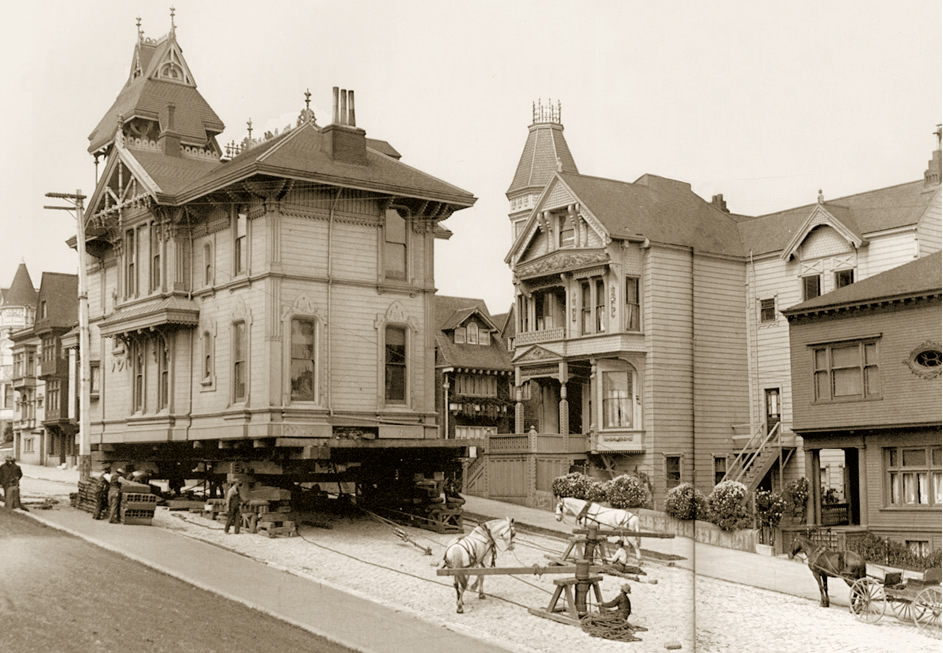
Military use of horses in the mounted field artillery
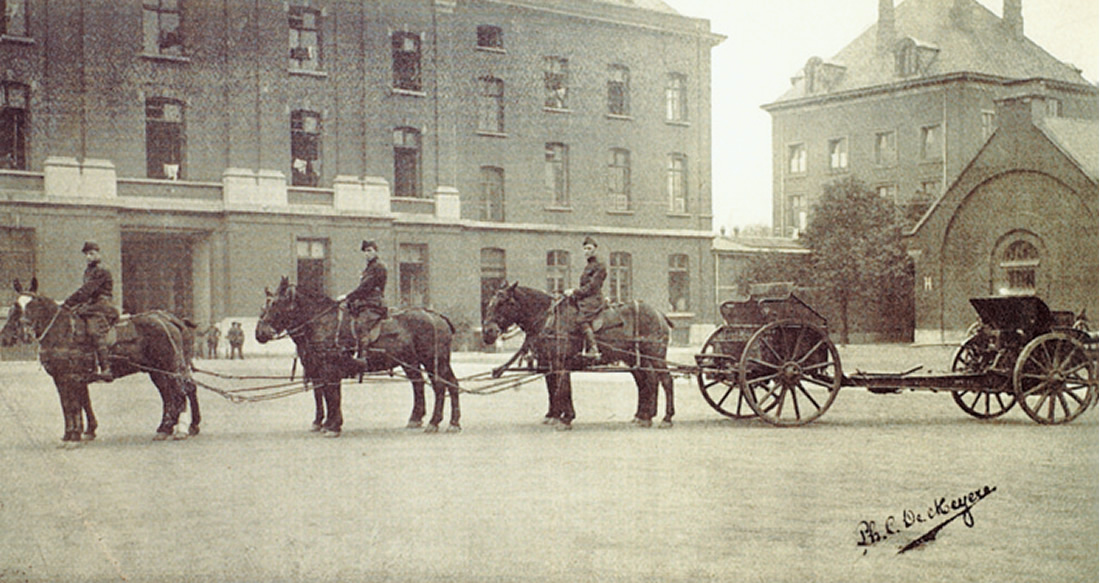
Horses in the coal mines in northern France
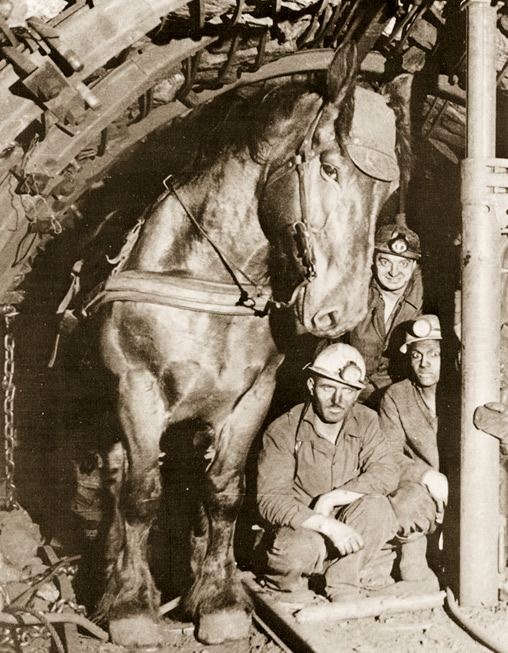
Draught horses were used for public transport (in the early 19th century).

The Van der Goten family moving house in Brussels

Use by the fire brigade (Boston 1910)
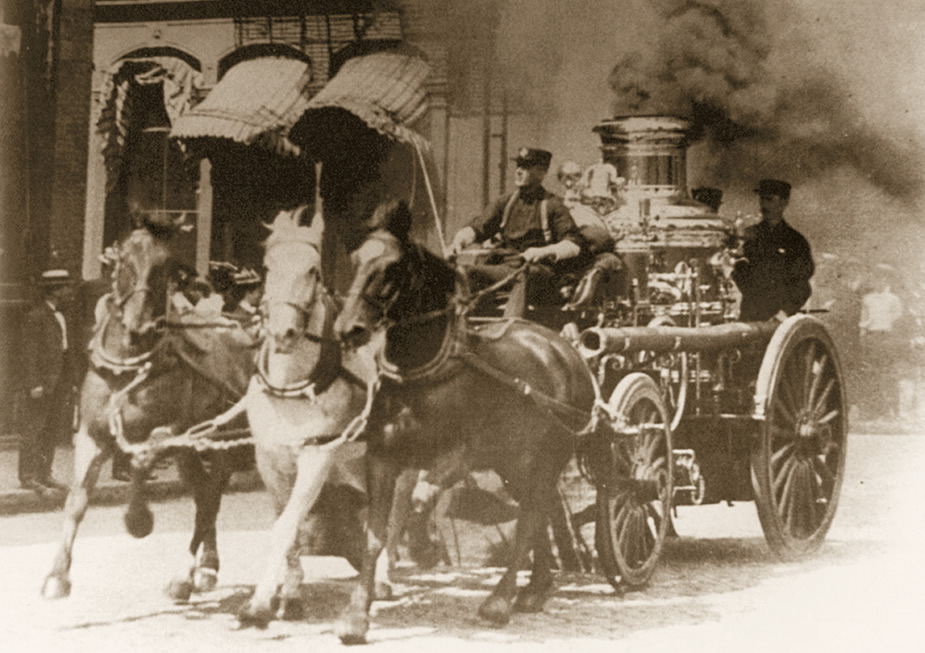
Warehouse horses in the port of Antwerp
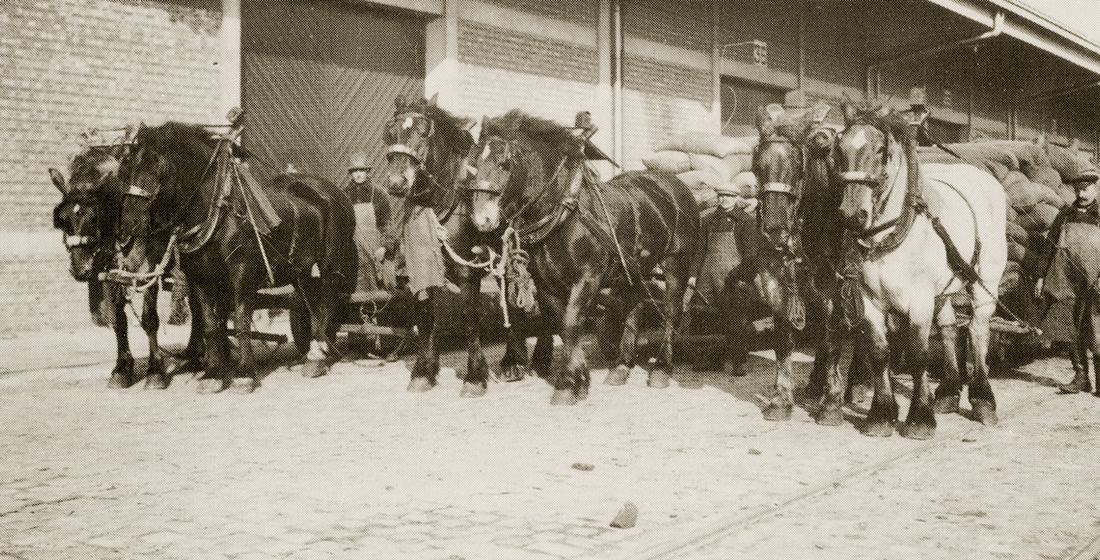
Horses ploughing.
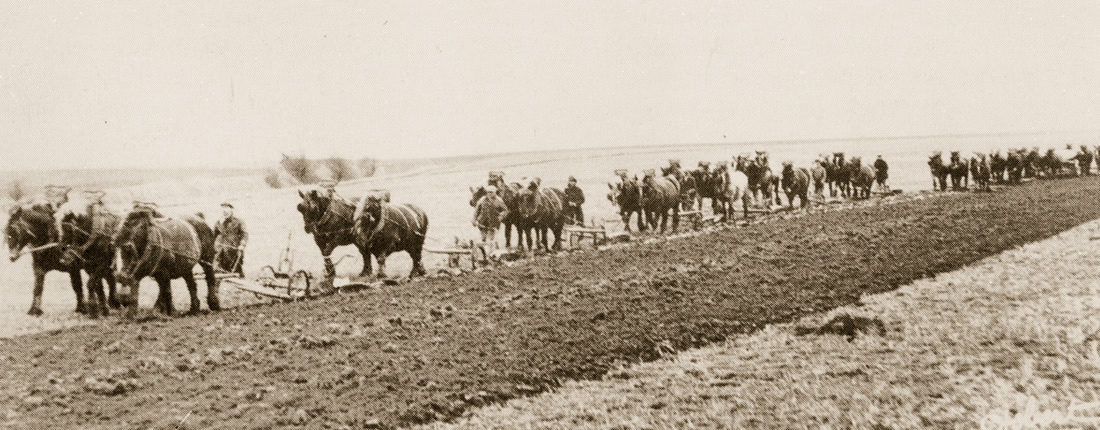
Contemporary use of draught horses in forestry, tourism, folklore, sport and recreation
The Belgian draught horse in forestry

Shrimpers in Oostduinkerke
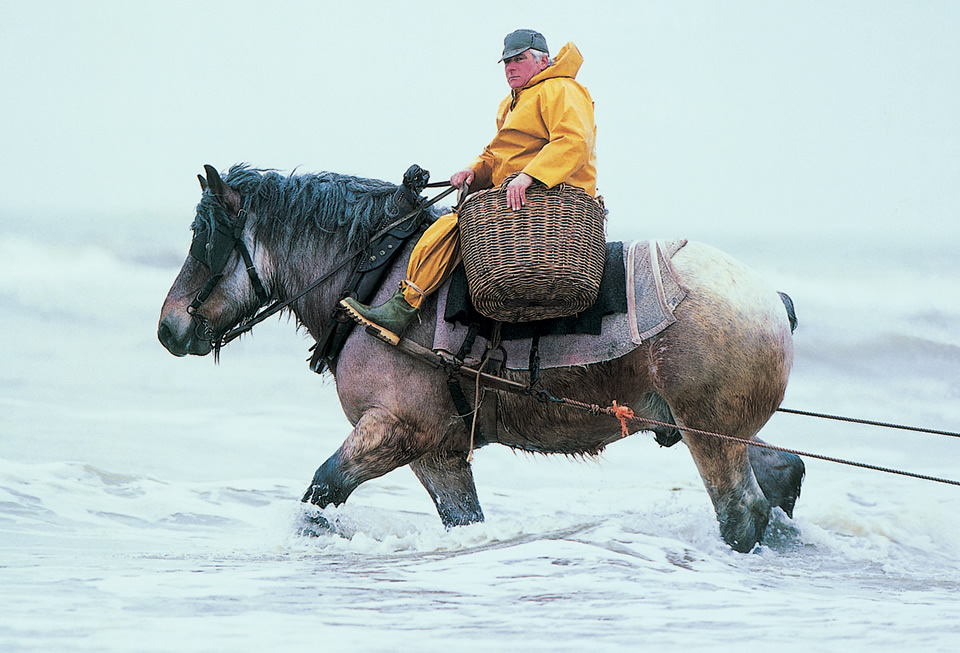
Tourism in Antwerp
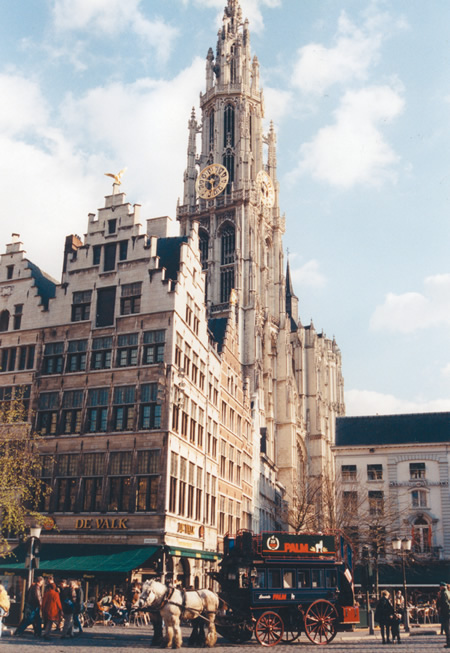
Horse procession in Hakendover
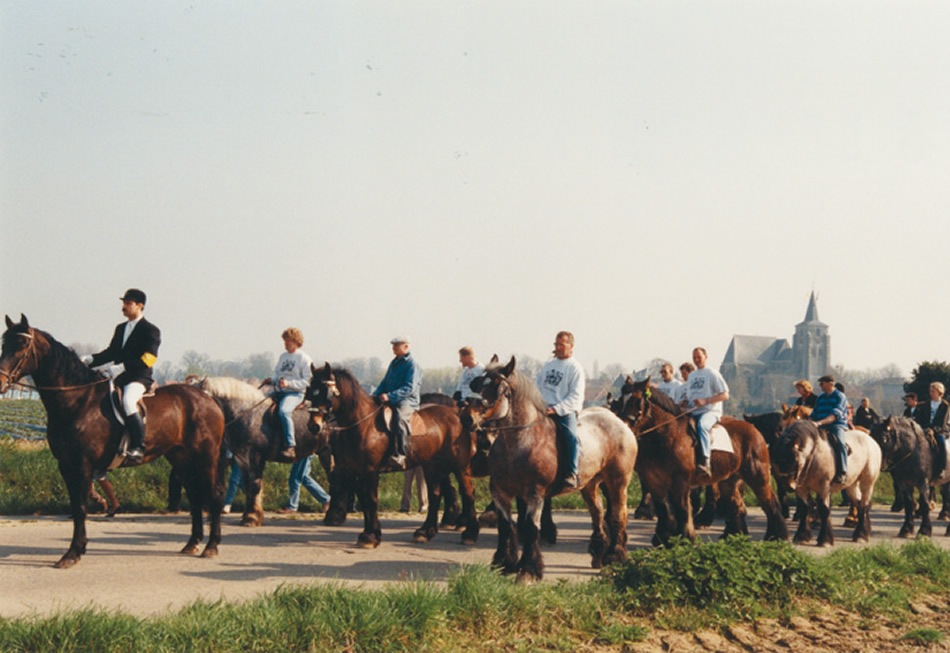
Recreational and sports horse driving using traditional carriages
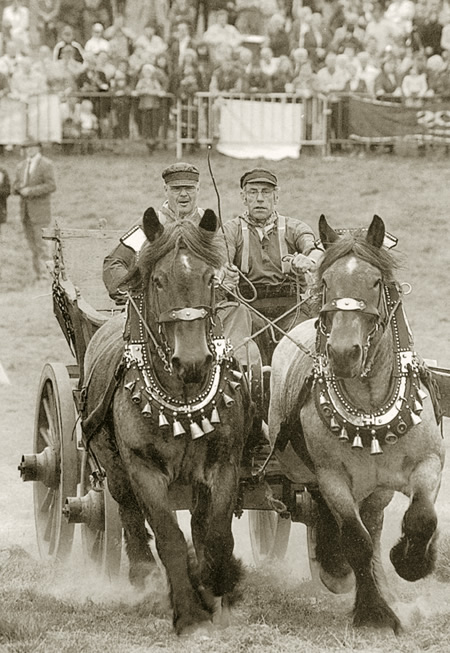
Tilt at the ring at Walcheren

Recreational horse driving in nature

Competitive horse driving in contemporary carriage

